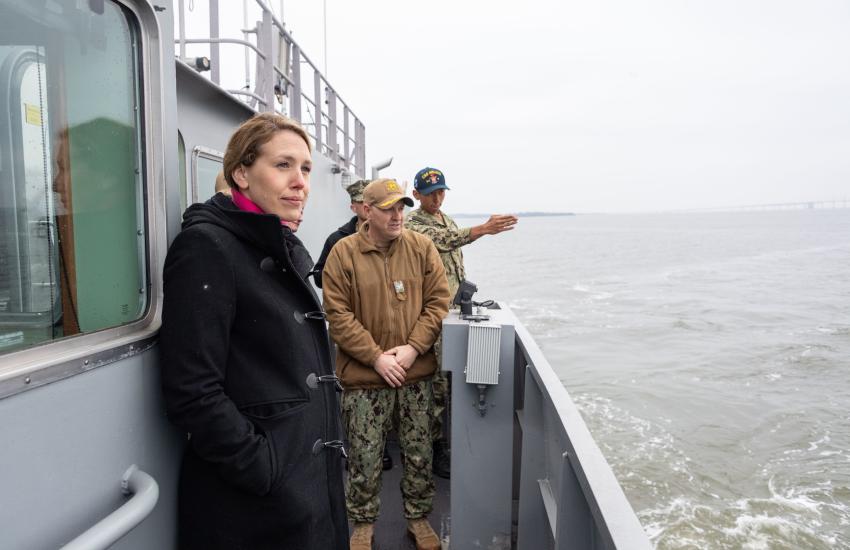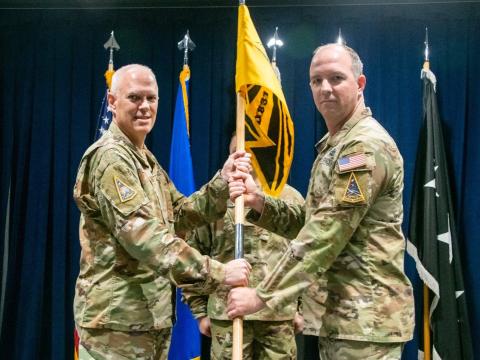Hope Is Not a Strategy When It Comes to Climate Resilience
Climate change, though a historically controversial topic, has and is causing serious national security concerns, according to current U.S. and worldwide military leaders. The U.S. Navy is among those seeking strategies to best tackle the problem.
At the early age of 7, Meredith Berger wrote a letter to President George Bush with a plea to save the rainforests. President Bush replied in agreement and shared her concern.
Berger grew up in south Florida, where hurricanes continue to grow in intensity and cause an increasing amount of damage. When the Gulf of Mexico experienced its large-scale oil spill in 2010, Berger learned the true importance of connecting climate and security with the water energy nexus. She understood that the U.S. infrastructure and communities must be resilient and ready for climate threats, her representatives told SIGNAL Media.
In 2012, NASA’s official site released an article titled “U.S. Navy bracing for climate change.” The Navy’s Task Force Climate Change (TFCC) was cited in the story addressing the issues that climate change had already brought to the Navy’s operations and structure. “When people see the Navy is addressing this issue [climate change], it may take them by surprise … Once they listen to why we care, they understand it is a legitimate concern and why we’re taking a proactive approach to discussing it,” the article quoted Courtney St. John, the Climate Changing Affairs Officer for the U.S. Navy’s TFCC, launched in 2009.
During his election campaign, President Biden committed to tackling the climate crisis. “The U.N.’s leading international climate scientists called the latest climate report nothing less than, quote ‘code red for humanity,’” he stated at Brayton Point Power Station in July 2022.
It wasn’t until 2021 that climate funding was first identified in the Department of the Navy (DON) budget, prioritizing climate investments for adaptation, resilience, exercises, disaster responses, future planning and more.
On April 27, 2021, President Biden announced his key administration nominations in national security. Meredith Berger, formerly the deputy chief of staff for the Department of the Navy (DON) during the Obama-Biden administration, was nominated for assistant secretary of the Navy for energy, installations and environment for the Department of Defense (DoD).
In August 2021, Secretary of the Navy Carlos Del Toro selected Berger to perform the duties of the undersecretary of the Navy.
Less than a year later, the DON released Climate Action 2030, the climate strategy set to draw a path toward a cleaner and more agile fighting force.
“Climate readiness is mission readiness,” Berger told SIGNAL Media during an interview.
The 32-page plan highlighted various strategies and examples to achieve two main performance goals: building climate resilience and reducing the climate threat.
“We are the first responders in most [natural disaster] situations,” Berger explained. An environment that is continually challenged is that much more challenging for the force.
California has had to face extreme temperatures in recent years. The strained grid has caused forced blackouts or planned brownouts to allow support for the community. The Marine Corps Air Station Miramar has been a perfect example of energy resilience, according to Berger.
With an available microgrid, the base can store energy. “Miramar pulled off the commercial grid and went to their own energy sources and were able to allow more power to go back to the [Californian] community.”
Climate resilience and preparedness is what creates a warfighting advantage at both the tactical and strategical levels, Berger acutely noted.
Iraq and Afghanistan drew attention to the threats in the necessary commodity of water and fuel supply. “For every 50 convoys of fuel, a marine was lost or wounded,” Berger shared. The transportation alone was taking a soldier out of the fight, she explained. That is a tangible example of the impacts of climate change no matter how the situation is viewed.
Technology and increased fuel supplies will create more efficiency and the ability to stay on station longer without relying on those who may not be our partners or allies, says Berger. “At the same time, that means less greenhouse emissions that are going into the atmosphere ... contributing less to the warming of the planet.”
A true climate resilience success story is the Marine Corps Logistics Base (MCLB) Albany, the first net-zero energy base within the DoD. “Through innovative partnerships with local energy companies, putting in equipment like microgrids that helped manage and store energy, they were able to come to a net-zero certification for that base, and in some cases actually are giving energy back to the base,” Berger explained.
MCLB serves as the greatest example of all that can be achieved through a diverse and resilient supply of renewable energy. No matter the circumstances, the force can stay independent, while saving money and avoiding creating negative impacts on the changing climate.
“If we’re not having energy resilience, then we will not be able to ensure mission success, which is first and foremost for everything we do,” Berger stated.


Common themes in energy resilience are hybridization and electrification. And though, as stated in Climate Action 2030, many technologies already exist, the Navy continues to look for more ideas. Berger explained, “What’s going to keep us getting better is that we’ll continue to innovate, we’ll continue to be more efficient, and we’ll continue to have more of those ideas keep us ahead.”
In many cases, it is a matter of time until some capabilities and innovations can be set in place and used to the department’s advantage.
For Berger, what gives her confidence is seeing the sailors, marines, enlisted officers and civilians who make the Navy what it is. There is a link between being the best warfighters and being the best prepared, she said. “Understanding how to operate in a climate-challenged environment is something that we are integrating into our every day, into our future planning, into our resourcing and into ensuring that we are approaching everything with that advantage in mind.”
Unlike many other national security missions, the ever-changing climate is an ongoing critical issue and a safety concern for the American people and around the globe.
In an ideal world, there will be more examples such as MCLB. Partnerships with innovators and allies will help in the development of the conversation and implementation of climate strategy. This, however, is a fight to keep on fighting.
One of Berger’s first environmental success stories is from her time as a fifth-grade student who had executed a campaign to remove Styrofoam from her school’s cafeteria. Today, Berger is continuing that legacy by improving the sustainability of food products at the Pentagon.
“This is a practice,” Berger stated. “This is a mindset of how we continue to create an advantage."





Comments